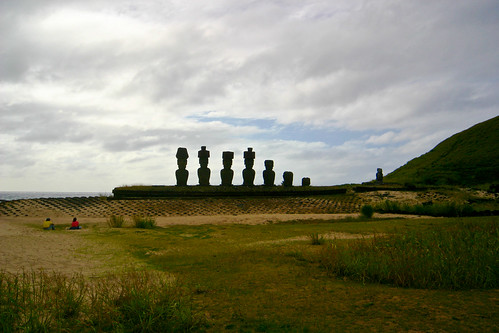The Mythology of Easter Island

Image : http://www.flickr.com
Mention Easter Island and most people immediately think of the enigmatic giant stone faces placed along the coastline that stare stoically, either out to sea or inland at the inhabitants. Being part of the Polynesian triangle in the Pacific there are many myths and legends attached to this remote and mysterious island, with many of the 'facts' being barely indistinguishable from fanciful conjecture.
However, what is indisputable is that the island has witnessed trauma and tribulation in almost equal measures over the last few centuries; including overcoming the threat of human extinction more than once. The local population have survived epidemics, famines, civil wars, slavery, hostile occupation and the near-collapse of their ecosystem, but are now thriving by promoting their incredible heritage and history to inquisitive visitors from all over the world.
In addition, the natural beauty of the island also provides stunning white sand beaches suitable for snorkelling and scuba diving, fishing and even surfing. An incredible caves network near Ana Kakenga - that was naturally created through the volcanic rock from which the island is derived - proves a big draw for many visitors. There are also opportunities to partake in horseback riding or bicycling, and to visit plenty of local crafts shops selling fantastic wood carvings.
Undeniably, the big attraction for most visitors to Easter Island is the giant heads - the vast majority of these remarkable monoliths are carved from compacted volcanic ash. Known as moai, they are dotted all over Easter Island and are actually enlarged heads attached to tiny torsos, with the latter regularly buried leaving only the face visible. Almost all the 887 moai were toppled during tribal wars in the 18th and 19th centuries and it wasn't until the 1950s that a concerted effort to stand them upright began, following extensive excavations by explorer Thor Heyerdahl.
There is much to see relating to the moai, starting with the quarry where they were all extracted and carved at Rano Raraku. Here is clear evidence of the tools used to carve the heads - simple stone chisels - and also a vast number of moai that never left the quarry. In fact, only one quarter of those carved ever made it to installation and it is estimated that it took six men a year to carve each monument.
Discovered and named on Easter Sunday 1722 - by Dutch explorer Jacob Roggeveen - Easter Island is a territory of Chile, even though it is situated some 2,300 miles west of South America. The most remote inhabited island in the world measuring a mere 15 by 10 miles, its nearest neighbour - a mere 1,260 miles away - is the even smaller inhabited island of Pitcairn. And because it is so remote, there is no other viable option but to take flights to Easter Island if you wish to visit this remarkable island.
And, if you do wish to travel to Easter Island then make sure that you allow enough time to see everything, as despite its small size the island is literally stuffed with attractions.
Daniel Collins writes on a number of topics on behalf of a digital marketing agency and a variety of clients. As such, this article is to be considered a professional piece with business interests in mind.
0 comments:
Post a Comment